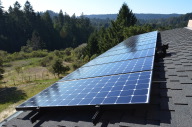For years I’ve dismissed those little semi-autonomous, robotic sucking machines. It sounded like they weren’t really worth the trouble since they couldn’t really run for very long, pick up much debris in their tiny compartments, deal with furniture without missing spots or getting stuck or trapped. With all the need to supervise, it sounded easier and quicker to do it yourself. But then recently I stumbled on a review of a new model and was intrigued by the improvements and the possibility of a little machine to help keep up on all that cat hair my two furry friends are always producing.
A fun video showing my new little helper in action (1.5 minutes, 24 MB)
It’s the BotVac 80/85 from Neato. Unlike its more well-known competitor (iRobot Roomba), this robotic vacuum cleaner does not just follow a random walk around the room, bumping haphazardly from one obstacle to the next. The BotVac uses laser sensors to map out the shape of each room and build up a floor plan as it goes about its business. When it encounters obstacles like tables and chairs, it will actually work to navigate around each leg, vacuuming under and around as much as it can. It’s pretty amazing (and mesmerizing) to watch it navigate around the house, room after room, following its little internal rule sets to deal with various obstacles as they come up.
- When the BotVac gets low on charge, it will actually backtrack through the map it built to return to its charging base and dock itself for recharging, even off in another room. And when it has finished recharging it will return by itself to where it left off and continue the job!
- It’s got touch sensors in front to help it maneuver tightly to objects and walls.
- It has a sensor underneath to keep it from running off a cliff (or stairs).
- It comes with some magnetic strips that you can lay down on the floor to cordon off rooms or areas that you don’t want it to intrude on. (It’s much simpler than the battery-operated “fence” posts that the iRobot apparently uses.)
- It has a little edge-cleaning brush on the right side. (Thus it will always approach walls and make its rounds in a right-handed path.)
- It’s squared off in front so that it can get into corners much better than fully round designs like the Roomba.
- It has a larger-than-typical dust bin and it’s very easy to remove and empty out – without even having to turn over the unit. It makes sense to also vacuum out the dust filter though.
- You can set a schedule for when it should run but this doesn’t seem practical to me as I would first want to clear stuff off the floor and make sure there aren’t any cat messes that it would get into – and make worse. (Hera often has stomach issues.)
It’s not quite a replacement for a full-size vacuum cleaner but it certainly does an amazing job considering that you can just start it up and let it go while you go about doing other things. (You also do need a normal vacuum cleaner to clear out its filter.) It’s pretty cool though to come back and find everything freshly vacuumed! And it’s not really that loud (certainly much less than a full size vacuum) and it’s not too annoying to have it going about it’s business while you do other things.
One limitation with the BotVac is that at about four inches tall, it can’t fit under some furniture, particularly couches. (The Roomba design has a lower profile and can fit under more furniture.) Also, the BotVac can get itself stuck at times and need help. This happens sometimes with furniture that offers just enough clearance for it to partially slip under but not quite enough for it to fit entirely under. Often this goes fine and it will just work its way around, but other times it’ll get itself wedged in and need to be pulled out. When it does get stuck or trapped, it will cut power to its vacuum and call for help by chiming. It’ll then sit and wait quietly for a while before chiming now and again.
Here’s a much more mixed review of the BotVac that comes out in favor of the Roomba. Some more reviews: BotVac 85 vs. Roomba 880 (favors the BotVac) and iRobot Roomba vs Neato Botvac (favors neither).
Note that the BotVac 85 is really just the same model as the 80 but it comes with two extra filters included. (This wasn’t obvious to me.) Both the 80 and 85 come with the two different brush types.
Now… what should I name him?
UPDATE (1/28/2015): The BotVac is still running but I have seen more of its deficiencies. One thing that happens is that it essentially becomes a little senile with a low battery charge: it often has become unable to find its way back to its charge station with its battery runs low. It will repeatedly and aimlessly search a small area (a couple of square feet) and after a long while finally give up and call for help – this without any obstacles in the way. My guess is that it lets the voltage level drop too far on the battery now and is unable to sufficiently power its electronics and sensors. At first it only happened occasionally, then it started happening almost every time. But then, more recently (April 2015), it’s been working properly again! Weird. Anyway, when it does “go senile”, I have to pick it up and manually dock it at its charge station. (If I let it continue its search for the dock right in front of it, it will just wander off again.)
The other issue (and this is more annoying) is that its methodical method of covering a room means that it will get into try over and over again (unsuccessfully) to reach some particularly difficult spot (due to furniture) and waste a lot of its battery charge or even eventually get itself wedged in or otherwise stuck. Bringing it back out again will often lead to it just finding its way right back into that spot. I’ve since got into the habit of leaving some strategically placed pillows or other items to prevent it from getting into those spots. This is where I imagine the Roomba might do better with its random walk pattern: it probably won’t get stuck obsessively trying to reach the same spot.
Lastly, as I mentioned earlier, the biggest problem with the BotVac is the little laser assembly sticks up in the center of the unit. This protrusion isn’t accounted for when the unit tries to go under some furniture so it can end up wasting energy trying over and over to get under some furniture or even getting wedged under such furniture.
However, the BotVac does still do a good vacuuming job and it’s great to be able to set it off running while you take care of other things.






















